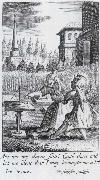|
Here are all the paintings of Francis Quarles 01
| ID |
Painting |
Oil Pantings, Sorted from A to Z |
Painting Description |
| 48482 |
 |
Emblemes |
mk190
1635
British Library
|
|
|
| Francis Quarles
|
| 1592-1644,was born at Romford, London Borough of Havering, and baptized there on May 8 1592. Francis traced his ancestry to a family settled in England before the Norman Conquest with a long history in royal service. His great-grandfather, George Quarles, was Auditor to Henry VIII, and his father, James Quarles, held several places under Elizabeth I and James I, for which he was rewarded with an estate called Stewards in Romford. His mother, Joan Dalton, was the daughter and heiress of Eldred Dalton of Mores Place, Hadham. There were eight children in the family; the eldest, Sir Robert Quarles, was knighted by James I in 1608. Francis was entered at Christ's College, Cambridge, in 1608, and subsequently at Lincoln's Inn. He was made cupbearer to the Princess Elizabeth, in 1613, remaining abroad for some years; and before 1629 he was appointed secretary to Ussher, the primate of Ireland. About 1633 he returned to England, and spent the next two years in the preparation of his Emblems. In 1639 he was made city chronologer, a post in which Ben Jonson and Thomas Middleton had preceded him. At the outbreak of the Civil War he took the Royalist side, drawing up three pamphlets in 1644 in support of the king's cause. It is said that his house was searched and his papers destroyed by the Parliamentarians in consequence of these publications. Quarles married in 1618 Ursula Woodgate, by whom he had eighteen children. His son, John Quarles (1624-1665), was exiled to Flanders for his Royalist sympathies and was the author of Fons Lachrymarum (1648) and other poems. The work by which Quarles is best known, the Emblems, was originally published in 1635, with grotesque illustrations engraved by William Marshall and others. The forty-five prints in the last three books are borrowed from the Pia Desideria (Antwerp, 1624) of Herman Hugo. Each "emblem" consists of a paraphrase from a passage of Scripture, expressed in ornate and metaphorical language, followed by passages from the Christian Fathers, and concluding with an epigram of four lines. The Emblems was immensely popular with the common people, but the critics of the 17th and 18th centuries had no mercy on Quarles. Sir John Suckling in his Sessions of the Poets disrespectfully alluded to him as he "that makes God speak so big in's poetry." Pope in the Dunciad spoke of the Emblems, "Where the pictures for the page atone And Quarles is saved by beauties not his own."
|
|

